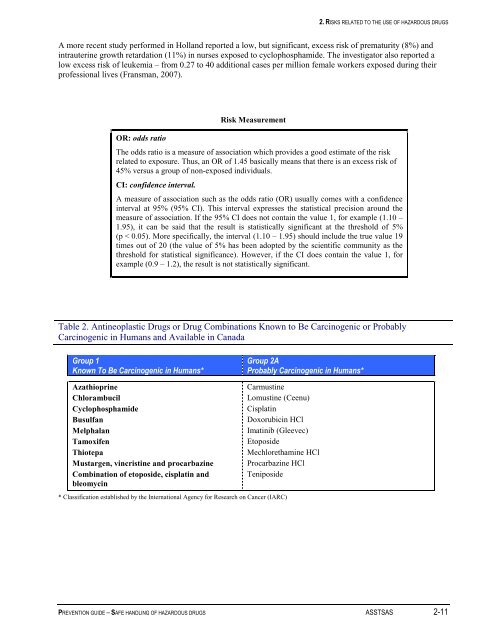Prevention Guide - Safe Handling of Hazardous Drugs - Irsst
Prevention Guide - Safe Handling of Hazardous Drugs - Irsst
Prevention Guide - Safe Handling of Hazardous Drugs - Irsst
You also want an ePaper? Increase the reach of your titles
YUMPU automatically turns print PDFs into web optimized ePapers that Google loves.
2. RISKS RELATED TO THE USE OF HAZARDOUS DRUGS<br />
A more recent study performed in Holland reported a low, but significant, excess risk <strong>of</strong> prematurity (8%) and<br />
intrauterine growth retardation (11%) in nurses exposed to cyclophosphamide. The investigator also reported a<br />
low excess risk <strong>of</strong> leukemia – from 0.27 to 40 additional cases per million female workers exposed during their<br />
pr<strong>of</strong>essional lives (Fransman, 2007).<br />
OR: odds ratio<br />
Risk Measurement<br />
The odds ratio is a measure <strong>of</strong> association which provides a good estimate <strong>of</strong> the risk<br />
related to exposure. Thus, an OR <strong>of</strong> 1.45 basically means that there is an excess risk <strong>of</strong><br />
45% versus a group <strong>of</strong> non-exposed individuals.<br />
CI: confidence interval.<br />
A measure <strong>of</strong> association such as the odds ratio (OR) usually comes with a confidence<br />
interval at 95% (95% CI). This interval expresses the statistical precision around the<br />
measure <strong>of</strong> association. If the 95% CI does not contain the value 1, for example (1.10 –<br />
1.95), it can be said that the result is statistically significant at the threshold <strong>of</strong> 5%<br />
(p < 0.05). More specifically, the interval (1.10 – 1.95) should include the true value 19<br />
times out <strong>of</strong> 20 (the value <strong>of</strong> 5% has been adopted by the scientific community as the<br />
threshold for statistical significance). However, if the CI does contain the value 1, for<br />
example (0.9 – 1.2), the result is not statistically significant.<br />
Table 2. Antineoplastic <strong>Drugs</strong> or Drug Combinations Known to Be Carcinogenic or Probably<br />
Carcinogenic in Humans and Available in Canada<br />
Group 1<br />
Known To Be Carcinogenic in Humans*<br />
Azathioprine<br />
Chlorambucil<br />
Cyclophosphamide<br />
Busulfan<br />
Melphalan<br />
Tamoxifen<br />
Thiotepa<br />
Mustargen, vincristine and procarbazine<br />
Combination <strong>of</strong> etoposide, cisplatin and<br />
bleomycin<br />
Group 2A<br />
Probably Carcinogenic in Humans*<br />
Carmustine<br />
Lomustine (Ceenu)<br />
Cisplatin<br />
Doxorubicin HCl<br />
Imatinib (Gleevec)<br />
Etoposide<br />
Mechlorethamine HCl<br />
Procarbazine HCl<br />
Teniposide<br />
* Classification established by the International Agency for Research on Cancer (IARC)<br />
PREVENTION GUIDE – SAFE HANDLING OF HAZARDOUS DRUGS ASSTSAS 2-11

















